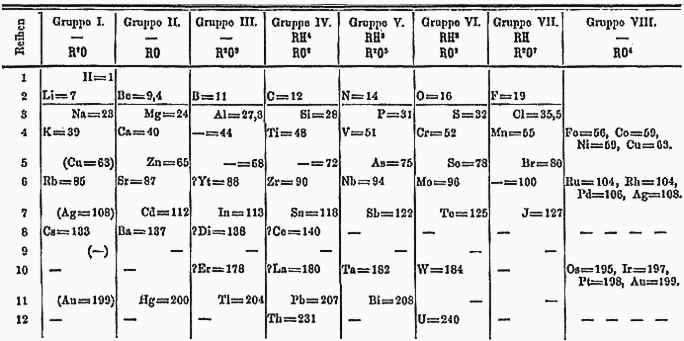The history of science offers excellent examples of intuitive leaps. Here are two that reveal a manner in which creativity is beyond logic, but not beyond investigation nor insights.
Dmitri Mendeleev ignored facts that were detrimental to his theory of the periodic of chemical properties, but this violation of logical principles didn’t ruin his theory.
Tycho Brahe and Johannes Kepler studied the same data yet they arrived at different answers. It was not a matter of right or wrong, but usefulness. These were not logical steps. They were intuitive leaps, based on patterns that were not perfect and on different theories brought to facts.
Periodic Table
Dmitri Mendeleev and the periodic table leap to my mind as a prime scientific discovery. Mendeleev saw that properties of elements repeated with regularity dependent on the element’s atomic mass. He assembled the period table in Figure in 1871.

At that time there were about sixty known elements. Arranged in this tabular form, Mendeleev made predictions that elements would be discovered to fill the dashed slots. In Gruppo IV (the fourth column), the third row is filled with Si (silicon) and its atomic mass. Two rows below silicon Mendeleev placed a dash and 72. He predicted that an element would be found with several distinct properties including an atomic mass of approximately 72. In 1886, germanium was discovered with nine measurable properties very close to Mendeleev’s predictions. Over time, additional open periodic table slots were filled with newly discovered elements.
Mendeleev’s Process
As marvelous as Mendeleev’s discovery was, let’s focus some attention on his process. He found a base rule (patterns repeating in eights). There were exceptions. Atomic weights do not give quite the same order as atomic numbers, now taken as the true repetition marker. Mendeleev ignored that contrary data, extended the rule beyond firm data, hypothesizing that the rule would hold.
Instead of a logical process, the period table was generated by an inductive process. A general rule was used. It had exceptions, but they were ignored. The general rule had a sufficient preponderance of evidence that the rule could be relied. This is reminiscent of the mind’s Almost Gate, which performs the same action when sufficiently similar inputs are received.
Mars Orbit
In the early 1600s, Tycho Brahe and Johannes Kepler using the same observational data of Mars’s orbit came to different conclusions. Brahe believed that the planets circled the sun, literally in circles. Kepler, on the other hand, discovered that elliptical orbits fitted the data better. However neither perfectly matched the data.
Brahe’s epicycles (circles upon circles) fit the data fairly well but they were complicated. Kepler’s ellipses also fit the data a bit better well but they required astronomers to discard the long-held belief that circular motion was the perfect motion and thus the proper movement for heavenly bodies. (Aside: Elliptical Orbits and Center of Mass.)
Elliptical orbits won that argument, because of their simplicity compared to epicycles. However, elliptical orbits brought with them a new astronomical system. A switch from the Brahe semi-Copernican (planets moved about the sun, but the sun moved about the Earth) to Kepler’s complete Copernican system (all planets including the Earth revolved about the sun).
Two Theories, Same Data
The data was identical. The explanations were different because the theories used were different. Logic was not the basis for the ascendancy of elliptical orbits. Simplicity, an aesthetic discriminant, was.
The theory or framework (worldview or mindset) brought to a problem affects the handling of the problem. This framework is not a characteristic of the problem. It is not a logical consequence of the problem. It is the predisposition that one brings to the situation from a life time of experiences filtered through ones genetic apparatus (particularly, one’s neural threshold).
Non-Logical Thinking
In these two cases of advancement in science, we’ve see two non-logical characteristics of creative discovery.
- Noticing a pattern or rule, yet ignoring contrary evidence. This occurs when the abundance of good data confirming the rule surpasses the barrier of the scientist’s Almost Gate.
- The worldview a person brings to a situation predates the situation and is not part of it, but that worldview affects how one approaches the situation.

Bob, well done; illuminates Almost Gate. MG